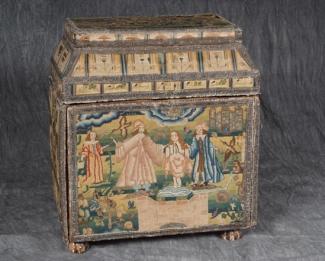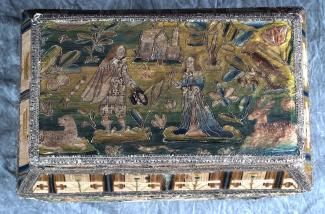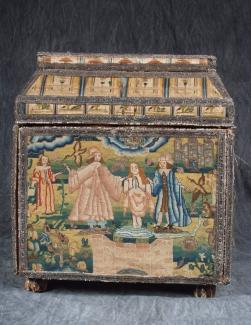This 17th century casket is a superb dated example of a specific type of female dressing table and travelling box, a number of which survive in museums and country houses across England. It was used to store personal possessions and treasures, for a girl who lived a life of some luxury in Oliver Cromwell's Commonwealth.
It is made of a light wood, probably boxwood. The four carved feet on which it stands are intact, and its original wooden outer carrying case also survives.
Inside there are two lids which lift to reveal different compartments, one of which includes some glass jars for ointments and cosmetics. There are also a series of drawers, for holding needlework tools, such as a pin cushion, tape measure and samplers. Other similar caskets have revealed writing equipment, small trinkets and keepsakes, or jewellery and other small accessories such as money and a drawstring purse. Two of the drawers are 'secret' - hidden from view - one was apparently for rings. The lining of the interior is in large part of pink silk, variously figured with a floral design, and stamped with shells. One interior section has a contemporary coloured engraving, the view of which is enhanced with mirrors.
On the outer sides there are a series of embroidered panels stitched in silks and metal thread. The panel on the lid shows a lady and gentleman in fashionable dress with a large house in the back ground, all the main features being outlined in couched thread.
On the front is a canvas-work panel, with fine tent stitch embroidery. This is the dated section, the date being embroidered at the top centre: 1655. In both panels the naturalistic detail of birds, insects and animals is clearly taken from contemporary woodcuts and engravings. On the sides and back, the embroidery is of laid floss silk threads, in stylised floral designs.
The embroidered panels are edged with silver needle-lace. The casket would have been put together professionally, after the embroidered sections had been completed.
Typically a child of eleven would be able to work this kind of embroidery at that period. The needlework skills she acquired would be put to good use when she came to manage a household of her own.
The casket has faded over the 350+ years since it was made, but it has clearly been well used and loved, and it reveals a considerable amount about the lifestyle, skills, imagery and materials available to a 17th century child.









